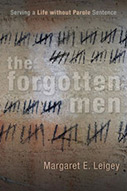The Forgotten Men: Serving a Life without Parole Sentence

Author: Margaret E. Leigey
Publisher: New Brunswick; London: Rutgers University Press, 2015. 242p.
Reviewer: William W. Berry III | November 2015
In recent years, the exorbitant costs of housing millions of individuals in prisons in the United States has finally started to garner the attention of state and federal legislators. Those once “tough on crime at all costs” have started to consider alternatives to mass incarceration. Ironically, it is these individuals, or in some cases their predecessors, that bear much of the responsibility for the carceral state in America of almost two and a half million prisoners.
Even among discussions concerning how to reverse the mass incarceration epidemic, life-without-parole sentences rarely capture much attention. The underlying assumption is that these individuals are, outside of death row, the worst of the worst, and would be last on the list for any sort of commutation, clemency, or release.
And yet, the life-without-parole population in the United States, approaching 50,000 offenders, is a phenomenon unseen in the history of the world. The product of a strange confluence of events—elimination of parole, the rise of mandatory minimum sentences, and the decline of the death penalty—the LWOP population encompasses a wide range of offender types representing a disparate set of crimes.
Indeed, as Margaret Leigey describes them, those serving LWOP are the “forgotten men.” In her book —The Forgotten Men: Serving a Life Without Parole Sentence—Leigey attempts to lift the veil to offer a view into the lives of a few of the many individuals serving LWOP sentences. Rescuing these individuals from the “out-of-sight, out-of-mind” existence of a death-in-prison sentence, Leigey’s narrative sets out to demonstrate what this condemnation looks like for the condemned.
The author begins her narrative by providing a helpful overview of the rise of LWOP and the epidemic that it has become, before exploring the rationales for and against the use of LWOP. She points in particular to three rationales that explain the use of LWOP sentences: (1) LWOP is an acceptable alternative to the death penalty; (2) life sentences should mean “for life”; and (3) it provides an exemplar for politicians to demonstrate that they are tough on crime. She correctly indicates how the increased use is the product of the liberal agenda of diminishing the use of the death penalty and the conservative view that judges and parole boards are too lenient.
She then catalogues the many problems with LWOP sentences, including that they are as inhumane as the death penalty, the exorbitant cost of LWOP, the international opposition to LWOP, the myth of a public desire for increased punishment, the disproportionate use with minorities, the lack of legal protections for the permanently incarcerated, and the decision to ignore the possibility of rehabilitation.
The principal value in Leigey’s book, though, is not in what she tells us, but in what she tries to show us. The product of two sets of lengthy interviews with 25 inmates serving LWOP sentences, one set in 2006 and one in 2011, this ethnography provides an interesting window into what it is like to serve a life-without-parole sentence. To her credit, her narrative does not attempt to over-dramatize their situations or exact sympathy for their plight. Instead, Leigey attempts to offer an unbiased factual presentation of their experiences.
She begins by cataloging the offenses of the men in the study. Twenty-one of the 25 men committed first-degree murder and four men were habitual offenders. Surprisingly though, most of the homicides did not involve deviant-group activities. Rather, the crimes were often the unintended consequence of burglaries or involved the killing of a significant other.
The author then explores the transition of the men from society into prison. The description by many of the men of this transformation as dream-like or arriving into another world is particularly telling. Two of the common reactions to this transition—suicidal ideation and prison misconduct—were part of the experience of some of the men in Leigey’s study. Interestingly, while a number of men initially engaged in bad conduct because they had “nothing left to lose,” many chose not to, or ceased such misconduct in order to maintain visitation privileges from family members. Also, some men noted that once they had established a reputation for being willing to engage in violence, others were less likely to engage them physically. Aging and maturation also apparently contributed to the increasing desire of the men over time to conform to prison rules.
The next stage that Leigey highlights in the development of the prisoners is the turning inward for self-assessment. This “awakening” occurred in many of the men in the study, and marked a transition, moving toward repentance and self-forgiveness. Many accepted responsibility for their actions, expressing remorsefulness in addition to their guilt and shame. A few of the men described a desire to find a way to help others, as they wanted in some way to atone for the life they had taken.
The central chapters of the book describe first the pain of permanent incarceration and then the methods by which some of the men cope with the harsh reality of a LWOP sentence. While it may not be difficult, in some senses, to imagine the pain of permanent imprisonment, the volume of comments from the men paints a decidedly grim picture. Using statement after statement from the men, Leigey bombards the reader over and over again with example after example of the suffering of the men. It is not her description, but their words that resonate so deeply. While the physical pain the men endure is significant, the psychological toll of repeated isolation seems to be what makes LWOP sentences so dehumanizing. In particular, as Leigey exhibits through the men’s words, are the deprivations they suffer—liberty, autonomy, privacy—as well as the emotional tolls of missing family, knowing release is unlikely, and the institutional thoughtlessness towards them.
More than anything, Leigey’s work in capturing the suffering of these men humanizes them for the reader, in spite of their criminal acts. Hearing their plight offers a reminder that these individuals are sons, husbands, and fathers, and have lives, albeit quite limited, that extend beyond their criminal pasts. Indeed, Leigey’s work shows the harm of defining an individual solely through their worst action or decision.
Having humanized the condemned through their own words, Leigey then demonstrates the many coping mechanisms they use to survive. For most, this was a mental game—finding ways to avoid complete despair. Inmates turned to their own inner strength, to religion, to work, to creative outlets, and to support from friends and family on the outside, all of which had the effect of taking their mind away from their condemnation. Interestingly, many of the inmates held out hope of release despite their LWOP sentence. Inmates also looked to each other to cope, and were often encouraged by even small acts of kindness from others. In the end, Leigey leaves surprised at the degree of resiliency shown by the men.
She also provides a glimpse into the later stages of a LWOP sentence—the process of growing old behind bars. The comments of the older men in the cohort raise the question of whether there is anything profitable about continued incarceration for some, particularly as their health declines. Consistent with prior research, Leigey found that the men’s mental health improved over time, while their physical health declined.
Leigey concludes her book with a series of policy recommendations. In particular, she recommends (1) using life with the possibility of parole sentences instead of LWOP; (2) the use of permanent parole for life-sentenced individuals who are released; (3) the inclusion of LWOP offenders in early release programs; (4) providing reentry services to reduce recidivism; (5) offering age and sentence specific programming; (6) allowing older LWOP offenders a voice in housing decisions; and (7) fostering greater institutional thoughtfulness.
This section is the weakest of her otherwise powerful monograph. While the ideas are generally good ones, the presentation of her recommendations would be more effective either as a laundry list or as a broader framework for reform. Leigey splits the difference here and leaves us with a series of good ideas that are under-developed, and that feel more like an afterthought. While she draws some connections with the comments of the men that she so carefully catalogued in the preceding chapters, one cannot help but feel that the final section fails to capture many of the problems inherent in the use of LWOP sentences. But then maybe offering a more robust reform agenda is beyond the scope of this project and should be left for other scholars (or Leigey herself) in another volume.
On the whole, the author has accomplished her purpose of helping those that read her book to remember the forgotten men. Achieving that is an accomplishment in itself. One can only hope that other researchers follow Leigey’s lead to help paint a broader picture of the dehumanizing nature of LWOP sentences. Until those outside the prison walls truly understand the reality of life inside the walls, reform of LWOP sentences will be a challenging endeavor.
William W. Berry III, Associate Professor and Jessie D. Puckett, Jr. Lecturer, University of Mississippi School of Law, Oxford, MS


